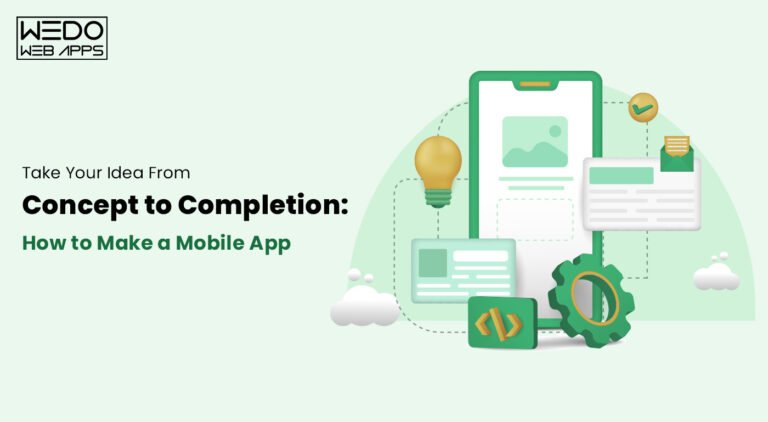30 Jan, 2023 | Mobile App Development
Take Your Idea From Concept to Completion: How to Make a Mobile App

Plan it Out: The App Design and Development Process
Before your app can be developed and launched to the public, a team of professionals need to work together to plan out the design and development process. This includes defining the core features, creating wireframes and technical specifications, setting deadlines, budgeting costs and making decisions about design. The plan should include all aspects related to developing a quality app that meets user needs — from concept to completion.Get the Design Right! UI/UX Considerations
As part of the design process, it’s important to consider the user experience (UX) and user interface (UI) of your mobile app. With the increased importance placed on UX, developers now need to be aware of both how users interact with an application and understand how they navigate through its features. The UI should be intuitive and should flow seamlessly between app screens while being aesthetically pleasing enough to keep users engaged. It’s also helpful to create wireframes which can help visually explain core functions and UX flows.Identify Your Tech Stack (By Platform)
When it comes to the development stage, there are two main platforms you can use to make an app — native and cross-platform. Native apps are written with the programming language of within their platform (iOS or Android). A cross-platform app uses a single codebase that is then adapted for each of the platforms. The tech stack for your app will depend on which type you decide to go for. You’ll need to identify which frameworks, languages, architectures, and database solutions will work best. This step requires a bit of research and experience from someone who knows your particular sector like a digital agency or freelancer.Build It: Getting Started with App Development
When starting the development process, first decide on your app’s platform — iOS or Android? If you can afford both, then it’s essential that you consider your user experience. Look at how each platform works for your product and research the most popular platforms for apps similar to yours in terms of target market or purpose. Then pick a tech stack (programming language, database architecture etc.) and get coding! You might find the help from an experienced and qualified professional invaluable here. The design should go hand-in-hand with creating features; you won't have an engaging UI without any functionality! Throughout this crucial creating process, keep testing, making changes and improvements as bugs are found to ensure a seamless journey.
Quality Assurance: Test Your App Before Launch
Before going live with your mobile app development, it is crucial to thoroughly test it. Testing enables you to make sure your app works the way you intended and improves user experience. You should use both manual and automated testing depending on the complexity of your app and its features. This helps uncover errors or bugs that would otherwise have remained hidden from users had it not been tested properly. Find out how to take your idea from concept to completion with our guide on making mobile apps, and learn how a mobile app development agency in London can support you every step of the way.Frequently Asked Questions
The first step in making a mobile app is to come up with a concept or idea. Once you have your idea, you will need to research the market, identify your target audience, and determine what features and functionalities your app will need to have. You will then need to wireframe and prototype your app, which involves creating a basic design and layout for the various screens and features of your app. Once you have a prototype, you can begin development, which involves coding and programming your app. After development, you will need to test your app extensively to ensure it works properly and is free of bugs and glitches. Finally, you will need to market and promote your app to attract users and drive downloads. This may involve creating a website or social media presence, running advertisements, or partnering with influencers or other businesses in your industry.
Firstly, research the market to see if there is demand for the app idea. Look at similar apps and identify what makes yours unique. Conduct surveys or focus groups to gather feedback from potential users and determine if they would use your app. Additionally, research your target audience to identify their needs, preferences, and pain points. Use these insights to tailor your app to their specific needs and wants. Utilize data analytics to track user behavior and engagement to continually improve the app and adapt to your target audience.
When designing and developing an app, there are several key considerations that need to be taken into account. Firstly, it's important to identify your target audience and understand their needs and preferences. From there, you can begin to design an app that meets their specific needs and requirements. Another important consideration is user experience (UX) design. This involves creating an interface that is user-friendly and intuitive, so that users can quickly and easily navigate the app and find what they need. Beyond design, there are also technical considerations to keep in mind, such as choosing the right programming language, platform, and APIs. You'll also need to consider factors like scalability, security, and performance, to make sure your app can handle a large number of users and deliver a fast and reliable experience. Ultimately, the key to successful app design and development is a combination of technical expertise, user-focused design, and a deep understanding of your target audience's needs and preferences.
There are several ways to promote and maintain your app after launching it in the UK market. Firstly, ensure that you have a solid ASO (App Store Optimization) strategy in place, including relevant keywords, well-crafted descriptions, and engaging visuals. Utilize social media and advertising platforms to reach a broader audience and increase downloads. Collect feedback from users, analyze data, and continuously improve your app based on user needs and trends. Encourage users to share your app with others and offer incentives for referrals. Finally, stay up to date with technology and industry trends to ensure your app remains relevant and competitive.
First, identify the core purpose of your app and what problem it is solving for users. From there, categorize features and functionalities into "must-haves" (essential for the app to function and meet its purpose), "should-haves" (important but not essential), and "nice-to-haves" (features that would enhance the user experience but are not essential). Prioritize the must-haves and should-haves before considering adding any nice-to-haves. It's also important to gather user feedback and consider their needs and preferences when determining which features to prioritize.

